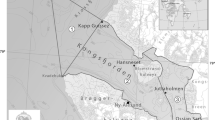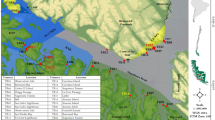Abstract
Photographic samples were taken every 5 m along two 40 m transects on mostly rock face at Signy Island, Antarctica, during the austral winter of 1991. Dense and taxonomically rich communities of benthos occurred at most of the sublittoral study locations. These communities, however, varied significantly with substratum type, substratum profile and depth. Algae were generally the largest occupiers of space, but the area of substratum colonised by animal taxa increased whenever the profile approached vertical. Shallower than 15 m, disturbance effects, largely from ice, restricted community development to a high degree, but the frequency of disturbance at 25 m appeared to maintain high diversity by preventing domination of the assemblage by a few competitively superior taxa. Bryozoans, and to a lesser extent sponges, were the most abundant animal phyla. Among the bryozoans, species with an encrusting growth form occurred at the shallowest depths followed by encrusting massive/folaceous species and, at 40 m, the erect flexible forms. The ratio of encrusting to erect bryozoan species changed rapidly over the 0 to 50 m depth zone, from exclusively encrusting at 0 to 5 m to approaching 1 at 50 m. The erect bryozoans studied, from the shallow sublittoral to 290 m, could be classified as encrusting massive (foliaceous), erect flexible or erect rigid forms. There was some suggestion, despite the overlap between groups and considerable intra-group variation, that encrusting massive forms were abundant in the shallowest water, followed by erect flexible forms and then erect rigid forms with increasing depth. Some species which occurred as encrusting massive/foliaceous forms in deeper water occurred mostly in encrusting form only in shallow water (<15 m).
Similar content being viewed by others
References
Arntz WE, Brey T, Gallardo VA (1994) Antarctic zoobenthos. Oceanogr mar biol A Rev (in press)
Barnes DKA (1994) Communities of epibiota on two species of erect antarctic Bryozoa. J mar Biol Ass UK 47: 863–872
Barnes DKA (1995) Antarctic epifaunal sublittoral communities. I. The ice-foot zone. Mar Biol 121: 555–563
Barnes DKA, Clarke A (1994) Seasonal variation in the feeding activity of four species of antarctic Bryozoa in relation to environmental factors. J exp mar Biol Ecol 181: 117–133
Belyaev GM, Uschakov PV (1957) Certain regularities in the quantitative distribution of the benthic fauna in antarctic waters. Dokl Akad Nauk SSSR 112: 137–140
Bullivant JS (1961) Photographs of antarctic bottom fauna. Polar Rec 10: 505–508
Bullivant JS (1967) Ecology of the Ross Sea benthos. NZ J mar Freshwat Res 32: 49–75
Cheetham AH (1971) Functional morphology and biofacies distribution of cheilostome bryozoa in the Danian Sea (Paleocene) of southern Scandinavia. Smithson Contr Paleobiol 6: 1–87
Clarke A (1980) A reappraisal of the concept of metabolic cold adaptation in polar marine invertebrates. Biol J Linn Soc 14: 77–92
Clarke A (1988) Seasonality in the Antarctic marine ecosystem. Comp Biochem Physiol 90B: 461–473
Clarke A, Holmes LJ, White MG (1988) The annual cycle of temperature, chlorophyll and major nutrients at Signy Island, South Orkney Islands, 1969–82. Br Antarct Surv Bull 80: 65–86
ConnellJH (1978) Diversity in tropical rain forests and coral reefs. Science, NY 199: 1302–1310
Dayton PK, HesslerRR (1972) Role of biological disturbance in maintaining diversity in the deepsea. Deep-Sea Res 19: 199–208
Dayton PK, Robilliard GA, Paine RT (1970) Benthic faunal zonation as a result of anchor ice at McMurdo Sound, Antarctica. In: Holgate MW (ed) Antarctic ecology. Vol. 1. Academic Press, London, pp 244–257
Dayton PK, Robilliard GA, Paine RT, Dayton LB (1974) Biological accommodation in the benthic community at McMurdo Sound, Antarctica. Ecol Monogr 44: 105–128
Fenchel T (1990) Adaptive significance of polymorphic life cycles in Protozoa: responses to starvation and refeeding in two species of marine ciliates. J exp mar Biol Ecol 136: 159–177
Galéron J, Herman RL, Arnaud PM, Arntz WE, Hain S, Klages M (1992) Macrofaunal communities on the continental shelf and slope of the southeastern Weddell Sea, Antarctica. Polar Biol 3: 283–290
Garwood PE, Vadas RL, Ojeda FP (1985) Competitive interactions among crustose coralline algae. In: Abstracts of the 24th Northeast Algal Symposium. Woods Hole, Massachusetts p. 12
Grime JP (1973) Control of species density in herbaceous vegetation. J envirl Mgmt 1: 151–167
Grosberg RK (1981) Competitive ability influences habitat choice in marine invertebrates. Nature, Lond 290: 700–702
Gruzov EN (1977) Seasonal alterations in coastal communities in the Davis Sea. In: Llano G (ed) Adaptations within antarctic ecosystems. Proceedings of the Third SCAR Symposium on Antarctic Biology. Smithsonian Press, Washington, pp 263–278
Harmelin J-G (1985) Bryozoan dominated assemblages in Mediterranean cryptic environments. In: Nielson C, Larwood GP (eds) Bryozoa: Ordovican to Recent. Olsen & Olsen, Fredensborg, Denmark, pp 135–143
Harmelin J-G (1986) Patterns in the distribution of bryozoans in the Mediterranean marine caves. Stygologia 2: 10–24
Hayward PJ (1991) Systematic studies on some antarctic and subantarctic Ascophora (Bryozoa, Cheilostomata). Zool J Linn Soc 101: 299–335
Hayward PJ (1992) Some antarctic and subantarctic species of Celleporidae (Bryozoa, Cheilostomata). J Zool, Lond 226: 283–310
Hayward PJ (1993) New species of cheilostomate Bryozoa from Antarctica and the subantarctic wouthwest Atlantic. J nat Hist 27: 1409–1430
Hayward PJ, Ryland JS (1990) Some antarctic and subantarctic species of Microporellidae (Bryozoa, Cheilostomata). J nat Hist 24: 1263–1287
Hayward PJ, Thorpe JP (1987) The systematic position of Smittina inclusa waters, an endemic antarctic Bryozoan. J Nat Hist 21: 1469–1476
Hayward PJ, Thorpe JP (1988 a) Species of Chaperiopsis (Bryozoa, Cheilostomata) collected by ‘Discovery’ investigations. J nat Hist 21: 45–69
Hayward PJ, Thorpe JP (1988 b) A new family of cheilostome bryozoans endemic to the Antarctic. Zool J Linn Soc 93: 1–18
Hayward PJ, Thorpe JP (1988 c) Species of Arachnopusia (Bryozoa, Cheilostomata) collected by the ‘Discovery’ investigations. J nat Hist 22: 773–799
HaywardPJ, Thorpe JP (1988 d) New genera of antarctic cheilostome bryozoa. Cah Biol mar 29: 277–296
Hayward PJ, Thorpe JP (1989 a) Membraniporoidia, Microporoidea and Cellarioidea (Bryozoa, Cheilostomata) collected by ‘Discovery’ expeditions. J nat Hist 23: 913–960
Hayward PJ, Thorpe JP (1989 b) Systematic notes on some antarctic Ascophora (Bryozoa, Cheilostomata). Zoologica Scr 18: 365–374
Hayward PJ, Thorpe JP (1990) Some antarctic and subantarctic species of Smittinidae (Bryozoa Cheilostomata). J Zool, Lond 222: 137–176
Huston M (1979) A general hypothesis of species diversity. Am Nat 113: 81–101
Jackson JBC (1979) Morphological strategies of sessile animals. In: Larwood G, Rosen BR (eds) Biology and systematics of colonial organisms. Academic Press, London, pp 499–555
Kirkwood JM, Burton HR (1988) Macrobenthic species assemblages in Ellis Fjord, Vestfold Hills, Antarctica. Mar Biol 97: 445–457
Knox GA (1970) Antarctic marine ecosystems. In: Holgate M (ed) Antarctic ecology. Academic Press, New York, pp 67–96
Logan A (1988) A sublittoral hard substrate epibenthic community below 30 m in Head Harbour Passage, New Brunswick, Canada. Estuar, cstl Shelf Sci 27: 445–459
Logan A, Page FH, Thomas MHL (1984) Depth zonation of epibenthos on sublittoral hard substrates off Deer Island, Bay of Fundy, Canada. Estuar, cstl Shelf Sci 18: 571–592
Luxmoore RA (1982) Moulting and growth in serolid isopods. J exp mar Biol Ecol 56: 63–85
McKinney FK, Jackson JBC (1991) Bryozoan evolution. University of Chicago Press, London
Ojeda FP, Dearborn JH (1989) Community structure of macroinvertebrates inhabiting the rocky subtidal zone in the Gulf of Maine: seasonal and bathymetric distribution. Mar Ecol Prog Ser 57: 147–161
Peck LS (1989) Temperature and basal metabolism in two antarctic marine herbivores. J exp mar Biol Ecol 127: 1–12
Peck LS (1992) Body volumes and internal space constraints in articulate brachiopods. Lethaia 25: 383–390
Peck LS, Clarke A, Holmes LJ (1987 a) Size, shape and distribution of organic matter in the recent antarctic brachiopod Liothyrella uva. Lethaia 20: 33–40
Peck LS, Clarke A, Holmes LJ (1987 b) Summer metabolism and seasonal changes in biochemical composition of the antarctic brachiopod Liothyrella uva (Broderip, 1833). J exp mar Biol Ecol 114: 85–97
Peck LS, Morris DJ, Clarke A (1986 a) Oxygen consumption and the role of caeca in the recent antarctic brachiopod Liothyrella uva notorcadensis (Jackson, 1912). Biostratigr Paléozoïque (Spec Publ) 4: 349–355 (Proc 1st int Conf Brachiopods, Brest, France)
Peck LS, Morris DJ, Clarke A, Holmes LJ (1986 b) Oxygen consumption and nitrogen excretion in the antarctic brachiopod Liothyrella uva (Jackson, 1912) under simulated winter conditions. J exp mar Biol Ecol 104: 203–213
Sanderson WG, Thorpe JP, Clarke A (1994) A preliminary study of feeding rates in the antarctic cheilostome bryozoan Himantozoum antarcticum In: Hayward PJ, Ryland JS, Taylor PD (eds) Biology and palaeobiology of bryozoans. Olsen & Olsen, Fredensborg, pp 167–170
Sebens KP, (1986 a) Community ecology of vertical walls in the Gulf of Maine, USA: small scale processes and alternative community states. In: Moore PG, Seed R (eds) The ecology of rocky coasts. Columbia University Press, New York, pp 346–371
Sebens KP (1986 b) Spatial relationships among encrusting marine organisms in the New England subtidal zone. Ecol Monogr 56: 73–96
Steneck RS (1978) Factors influencing the distribution of crustose coralline algae (Rodophyta: Corallinaceae) in the Damariscotta River estuary, Maine. M.S. thesis. University of Maine, Orono
Steneck RS (1986) The ecology of coralline algal crusts: convergent patterns and adaptive strategies. A Rev Ecol Syst 17: 273–303
Whitaker TM (1982) Primary production of phytoplankton off Signy Island, South Orkneys, the Antarctic. Proc R Soc Lond (Ser B) 214: 169–189
White MG, Robins MW (1972) Biomass estimates from Borge Bay, Signy Island, South Orkney Islands. Br Antarct Surv Bull 31: 45–50
Winston JE (1983) Patterns of growth, reproduction and mortality in bryozoans from the Ross Sea, Antarctica. Bull mar Sci 33: 688–702
Winston JE, Heimberg BF (1988) The role of bryozoans in the benthic community at Low Island, Antarctica. Antarctic J US 21: 188–189
Author information
Authors and Affiliations
Additional information
Communicated by J. Mauchline, Oban
Rights and permissions
About this article
Cite this article
Barnes, D.K.A. Sublittoral epifaunal communities at Signy Island, Antarctica. II. Below the ice-foot zone. Marine Biology 121, 565–572 (1995). https://doi.org/10.1007/BF00349467
Received:
Accepted:
Issue Date:
DOI: https://doi.org/10.1007/BF00349467




